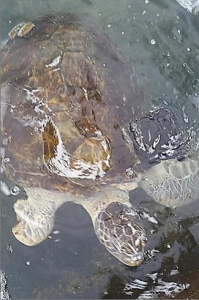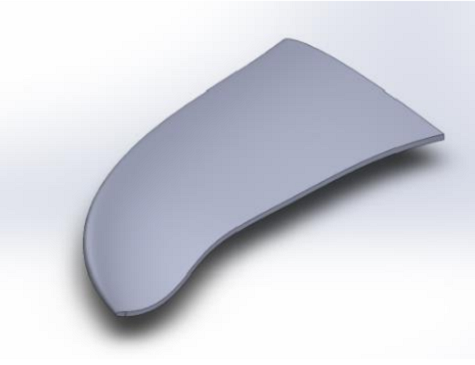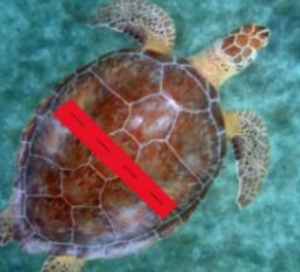A group of student researchers from the Worcester Polytechnic Institute (WPI) in Massachusetts wrote a paper, titled “Design of a Buoyancy Compensation Device and Prosthetic Flipper for a Green Sea Turtle,” about their work using 3D printing and molding to help a green sea turtle named Rocky who was having a hard time swimming after a boating accident.
 Green sea turtles are an endangered species, and due to predator attacks, boating mishaps, and debris in the water, many suffer the loss of a flipper. Additionally, a common buoyancy disorder, also called bubble butt syndrome, can keep turtles from diving and then naturally resurfacing, and is typically caused by intestinal gas that has been trapped because the turtle suffered a spinal cord injury or ingested plastic debris.
Green sea turtles are an endangered species, and due to predator attacks, boating mishaps, and debris in the water, many suffer the loss of a flipper. Additionally, a common buoyancy disorder, also called bubble butt syndrome, can keep turtles from diving and then naturally resurfacing, and is typically caused by intestinal gas that has been trapped because the turtle suffered a spinal cord injury or ingested plastic debris.
Rocky, who lives at the Key West Aquarium in Florida, was struck by a boat, which caused him to lose a front right flipper and to suffer from spine damage, which in turn led to a buoyancy disorder toward the back right of his shell which makes it difficult for him to breathe properly, dive for food, and swim in a straight line.
In order to continue living a normal life, he needed a new buoyancy compensation device and a prosthetic flipper, and after the aquarium reached out to the university, the WPI researchers vowed to help him.
The abstract of the paper reads, “This project aims to develop a floatation device to counteract Rocky’s buoyancy disorders as well as a prosthetic flipper to imitate his healthy flipper. The flipper was fabricated using 3D printing and molding processes. Adapting from previous projects’ calculations, a flipper was developed that will work as effectively as a healthy fin. The attachment mechanisms were designed by the project team and will be developed in collaboration with Hanger Prosthetics in Orlando, Florida. The team also created a generalized process, demonstrated in an instructional pamphlet and video, that can be used to assist in making prosthetics for other sea turtles.”
In addition to creating a buoyancy compensation device and prosthetic flipper, the team wanted to make sure that others could benefit from their work in the future. So they also developed a generalized process for creating a prosthetic flipper by taking pictures and videos of their work, then documenting the steps they took to create the flipper.
The researchers learned about the kinematics behind a turtle’s terrestrial and aquatic forms of movement in order to create the best possible prosthetic flipper. A sea turtle’s flippers, made of dense connective tissue, only make up less than 6% of the animal’s mass, but they are necessary in helping turtles stay alive.
“There are four things known to be true in the aquatic locomotion of a swimming turtle,” the team wrote. “The first is the swimming speed increases with an increasing stroke rate. Second, the stroke amplitude and force produced per stroke are directly proportional. Third, during both the up and down phases of a stroke the turtle is still producing a forward thrust carrying him ahead. Finally, the maximum thrust of a stroke is reached at the end of the downstroke cycle.”
Due to a hurricane, the aquarium was not able to provide the researchers with a CT scan of Rocky’s stump, which made it difficult to create the piece that would attach the prosthetic to the turtle’s body. So the team used previous CAD designs for a smaller sea turtle to design a modified prototype flipper, which was then 3D printed in two parts, glued together, and used to make a mold for the final prosthetic.
“During this project the team discovered that it is possible to build a prosthetic flipper from data that can be gathered by any aquarium staff, however; the quality of the prosthetic is much lower than one made using industrial grade equipment such as an MRI machine, and 3-D printer,” the researchers wrote.
The researchers collaborated with the aquarium to brainstorm possible designs for Rocky’s buoyancy compensation device. The final design is a modification to the team’s third idea of attaching a weighted, adjustable strap across the sea turtle’s shell with magnets, with heavier weight on the back right side of his shell.
The design is made out of FDA-approved neoprene material, which can effectively withstand salt water, and contains pockets so a maximum of 3.5 lbs worth of weights can be easily “dispersed and interchanged depending on where the gas is located at the time.”
“The team was challenged when trying to find suitable weights for the device as well as finding a method to sew the fabric together to create the pockets,” the paper stated. “These problems were solved by finding weights used in aquatic aerobics and utilizing the speedy stitcher sewing awl. Using these methods, the design can easily be replicated should another device be needed. The device will be attached to Rocky’s shell using cement putty. This is the method currently used by the aquarium and the buoyancy device in place. The putty is semi-permanent, so the device can be removed if needed.”
Hanger Prosthetics in Orlando will be testing and assembling both the 3D printed prosthetic flipper and the buoyancy compensation device for Rocky.
Co-authors of the paper are Maura Buckley, Katelyn Chagami, Kara Martin, and Julia Veitch. You can view their instructional video for 3D printing a prosthetic sea turtle flipper below:
Discuss this and other 3D printing topics at 3DPrintBoard.com or share your thoughts in the Facebook comments below.
Subscribe to Our Email Newsletter
Stay up-to-date on all the latest news from the 3D printing industry and receive information and offers from third party vendors.
You May Also Like
3D Printing Unpeeled: New Arkema Material for HP, Saddle and Macro MEMS
A new Arkema material for MJF is said to reduce costs per part by up to 25% and have an 85% reusability ratio. HP 3D HR PA 12 S has been...
3D Printing News Briefs, January 20, 2024: FDM, LPBF, Underwater 3D Printer, Racing, & More
We’re starting off with a process certification in today’s 3D Printing News Briefs, and then moving on to research about solute trapping, laser powder bed fusion, and then moving on...
3D Printing Webinar and Event Roundup: December 3, 2023
We’ve got plenty of events and webinars coming up for you this week! Quickparts is having a Manufacturing Roadshow, America Makes is holding a Member Town Hall, Stratafest makes two...
Formnext 2023 Day Three: Slam Dunk
I’m high—high on trade show. I’ve met numerous new faces and reconnected with old friends, creating an absolutely wonderful atmosphere. The excitement is palpable over several emerging developments. The high...




































